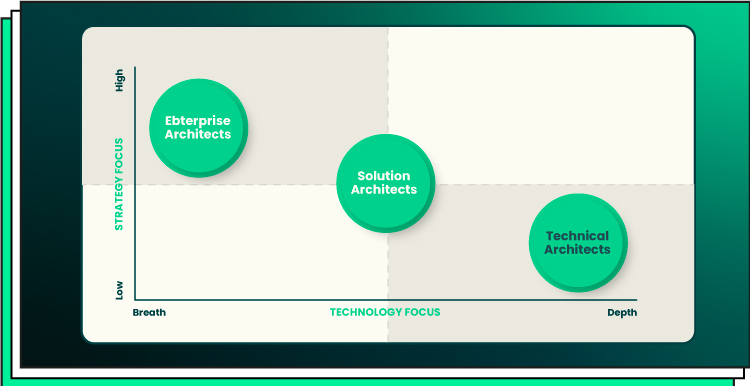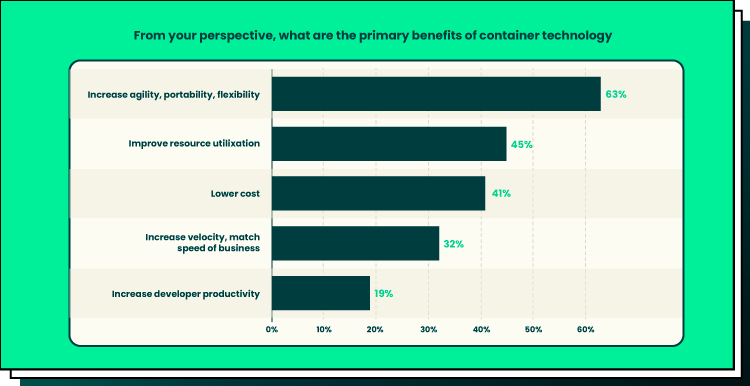In the digitally-powered age, going big time is impossible without embracing all assets of Industry 4.0. But sometimes, entrepreneurs are carried away by the idea of leveraging the latest technological advancements that appear absolutely irrelevant to their business goals. Or, having made a wise choice of software, they face problems in aligning it with the range of tasks it is supposed to fulfill. A solution architect is called to help companies avoid such pitfalls and other obstacles on the way to business success.
What Does a Solution Architect Do?
A solution architect role may be guessed from the very name. This specialist deals with the architecture of software products. But the essential part of the role of a solution architect isn’t covered by the title. The task of defining, designing, and implementing software architecture engineering is directly related to solving specific business needs.
Yet, in the IT expert market, there are other jobs where the word “architect’ is present. How do they differ? To have a straightaway answer to the question “What is solution architect?”, it is useful to make two comparisons: solution architect vs. enterprise architect and solution architect vs. technical architect.
Enterprise architects coordinate their efforts with key decision-makers of an organization and adopt a strategic vision to perform their duties. They assess the current technical condition of a company’s systems and infrastructure to understand how they dovetail into its goals. Then, they map out the changes to be implemented in the IT assets and list the facilities required to perform the transformational process.
A technical architect is a more down-to-earth specialist. They act on a lower level than enterprise architects and work in close cooperation with software development teams. Their responsibilities are limited by the nuts and bolts of building and deploying particular products an organization employs in its workflow. Technical architects are in charge of the entire software development lifecycle – from planning and road mapping to deployment, support, and maintenance.
It seems like all IT areas of an organization are covered by these two professionals, so what does a solution architect do? In fact, they form the middle level in the enterprise architect vs. solutions architect vs. technical architect structure.

The enterprise architect vs solution architect difference in tasks boils down to what vs. how opposition. The enterprise architect determines what is to be done to address a specific business challenge, whereas the solutions architect pinpoints how it should be done. Yet, before the project reaches the stage of practical implementation supervised by the technical architect, financial and managerial issues should be taken care of. And this is where a solution architect is also instrumental, thus linking the two levels within the organization’s hierarchy.
The difference between technical architect vs. solutions architect vs. enterprise architect becomes completely evident when we have a closer look at the solution architect responsibilities.
Key Responsibilities of Solution Architect
A solutions architect is nothing short of being a jack of all trades since their scope of responsibilities is rather extensive.
- Inspection and audit of the current technological environment. They draw a comprehensive picture of all IT resources of an enterprise (both hardware and software) to see what elements underperform and need improvement and where they are totally inadequate and require replacement.
- Analysis of the company’s peculiarities. A solutions architect must be aware of the nitty-gritty of the major shop floor processes, the core needs of the enterprise’s target audience, and the dominating market trends in the industry.
- Following the latest high-tech advancements. They must keep their finger on the IT pulse and spot novel know-how that can boost professional solutions leveraged by the enterprise and excel in solving pipeline tasks.
- Evaluation of the new products’ compatibility. Solutions architects must envisage the integration potential of the software they propose to onboard in terms of both current infrastructure and professional systems the company relies on.
- Assessment of the new solutions’ business feasibility. Architects should come to grips with the impact of the future solution on the organization’s business prospects.
- Dealing with specifications and requirements. In corresponding documents, a solution architect identifies the product’s features to be built and outlines its development and implementation stages.
- Definition of project constraints. They must be aware of the project’s limitations and devise possible alternative approaches and methods to see the project through.
- Risk management. It is not only about anticipating bottlenecks and threats, but also about mitigating them and mapping out a strategy for fixing problems if they do appear.
- Tech stack selection. A solutions architect’s technical expertise covers tools, programming languages, and frameworks they must be able to recommend to find the best fit for the specific IT-related tasks.
- Prototype design and development. By building a product’s prototype, they can validate the solution’s viability and envisage its upscaling potential and maintenance routine.
- Project implementation control. Solution architects supervise the entire lifecycle of product development, managing all aspects and fixing issues when they crop up.
- Providing communication among stakeholders. Both top brass and rank-and-file project team members should be kept on the same page regarding where they are and what they will do next.
Naturally, such a multitude of errands a solutions architect has to perform requires certain qualifications and competencies necessary for them.
Must-Have Skills for a Solutions Architect
To do their job well, a solution architect must possess the following skills.
1. In-depth technical skills
These are the bedrock capabilities for a solutions architect, which are obtained during at least six years of hands-on experience in the IT field. They cover:
- Operating and computer systems
- Web platforms
- Database, hardware, infrastructure, and product management
- Network administration
- Software architecture and infrastructure design
- Data and system security
- Cloud computing
- DevOps methodology
2. Superb analytical savvy
A high-end solution architect must pay attention to separate details in technical and business processes, keeping in view a broader picture at the same time. In this way, they can see how different elements work together and understand whether they dovetail into the overall corporate strategy and goals an enterprise aims to attain.
3. General resource and project management faculties
In fact, step-by-step project development isn’t included in the list of duties a solutions architect is meant to perform. However, these specialists are responsible for efficiently utilizing various resources (technical, human, and financial) and meeting deadlines. They must focus on choosing the best solution for achieving business results and thus maintain a long-term perspective, where upscaling opportunities and change adoption are taken into account.
4. Risk management knack
However perfect the future software product may seem, its implementation and functioning are always related to some financial, operational, compatibility, security, and other risks. A solution architect must be able to assess and prioritize them and take measures to mitigate such threats.
5. First-rate communication talent
Any of the skills mentioned above won’t help a solution architect to perform its duties on an adequate level if (s)he fails to interact efficiently with other stakeholders. The roster of people involved in the implementation of software projects is rather extensive. It includes such specialists as managers, developers, enterprise and technical architects, and other project team members who have their own responsibilities, visions, values, and tastes. A solutions architect must be flexible and responsive enough to collaborate with all of them, communicate to them onboarded policies, persuade, explain, and listen to their feedback.
In case a person possesses all these capabilities and – more importantly – never ceases to hone and upgrade them, (s)he has all chances to quickly progress up the career ladder in this field of expertise.
Career Path Opportunities in Solution Architecture
There is no one-size-fits-all standard for a solutions architect’s career path, but most people start with a software development, software engineering, or project management background. Naturally, it requires a bachelor’s degree in information technology and systems, computer science, or other related domains. Another necessary condition for a solution architect is 6+ years of practical experience as a software developer, network administrator, or expert in information technology.
A solutions architect’s most evident immediate career growth goal is to aim for an enterprise architect, which can be reached with some on-the-job training and another seven or more years of performing a solution architect’s responsibilities. However, the position of an enterprise architect isn’t the only vista that opens before a qualified and experienced solution architect. They can seek alternative careers in cloud and system engineering, technical consultancy, software engineering management, or even become the organization’s chief technology officer (CTO).
Dreams of career advancement, as well as efficient performing of their current duties, require a solution architect to keep track of the latest developments in software architecture.
Emerging Trends in Solution Architecture
Among the cutting-edge technologies that disrupt the contemporary software architecture realm, three deserve special attention.
Containerization
Basically, it means encasing applications and their dependencies into separate modules (containers) that can run anywhere after being deployed. Such an organizational model promises numerous boons to the solution’s developers, owners, and users.

Given such weighty benefits, it is no wonder that the global container technology market size currently manifests a spectacular CAGR of 26.5% and is likely to reach a breathtaking $8.2 billion within two years.
Serverless computing
This is a variety of cloud-native architecture that is a notch more flexible and cost-efficient. In fact, there is a cloud-based server, after all, where the solution is deployed. But unlike what happens in cloud computing, apps, and other solutions are launched only as needed, instead of being active even when they aren’t used at any particular moment. As a result, developers don’t have to worry about servers, and app owners save a pretty penny by paying only for the services they utilize and not for reserving a certain number of servers or a fixed amount of bandwidth.

Microservices
Having become a viable alternative to the old-school monolithic architecture, this software development approach consists in building a solution as a collection of independent services. It allows developers to produce and deploy the product much faster, which explains the growing popularity of microservices. As surveys show, over two-thirds of organizations rely on this architecture type in their current solutions or plan to harness it in the nearest future.
Of course, creating separate services requires an advanced level of coordination and collaboration between developers to provide seamless functioning of the entire product, but this is where a solution architect must step in to ensure its integrity and quality.
Summing It Up
One of the major challenges contemporary organizations have to address is the alignment of business goals with the professional software they employ in their shop floor activities. A solution architect is called to balance both aspects. They serve as a liaison between technical architects who are responsible for the hands-on development of software products and enterprise architects who are strategic visionaries of the company’s IT landscape.
If hiring an in-house solution architect is beyond your means, Forbytes is ready to provide you with an outsourced specialist alone or as a part of a dedicated team to bring your enterprise solutions to a new level.

Our Engineers
Can Help
Are you ready to discover all benefits of running a business in the digital era?

Our Engineers
Can Help
Are you ready to discover all benefits of running a business in the digital era?









